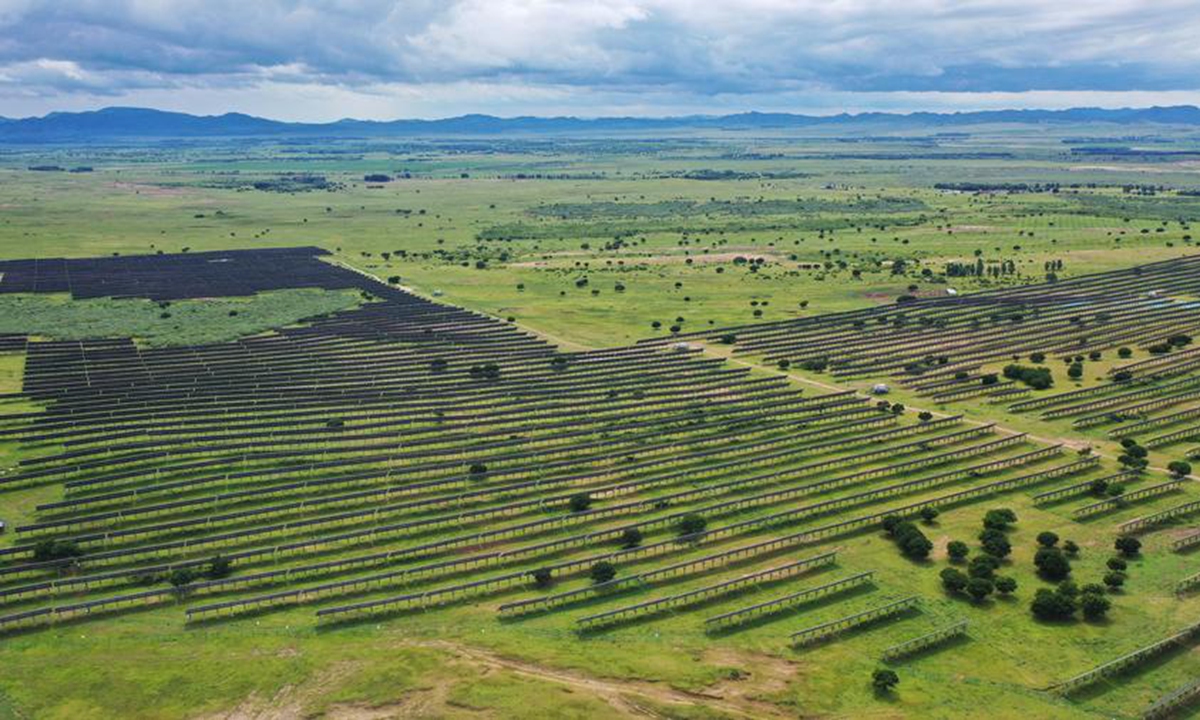
An aerial drone photo taken on July 29, 2025 shows photovoltaic panels at the site of a desertification control project integrated with wind and solar power facilities in Horqin Right Wing Middle Banner of Hinggan League, north China’s Inner Mongolia Autonomous Region. (Xinhua/Ding He)
Solar and wind energy outpaced the growth in global electricity demand in the first half of 2025, as renewables overtook coal for the first time in history, a report by the energy think tank Ember said, noting that China is the world’s leader in clean energy exploration and use.
Global solar power generation grew by a record 31 percent year-on-year in the first half of 2025, while wind energy generation grew by 7.7 percent, the UK-based Ember said in its Global Electricity Mid-Year Insights 2025 report, which was released on Tuesday.
Solar and wind energy met 109 percent of global electricity demand change in the first half, with solar power generation alone covering 83 percent of the world’s added electricity generation. “Record solar growth and steady wind expansion are reshaping the global power mix,” the Ember report noted.
Ember senior electricity analyst Małgorzata Wiatros-Motyka described the milestone as “a critical turning point.” Solar and wind are growing fast enough to meet the world’s growing appetite for electricity, marking the beginning of a shift where clean power is keeping pace with demand growth, she said.
Speaking of the milestone, UN Secretary-General António Guterres posted on his social media account, “The clean energy future is no longer a distant promise – it’s here.” He urged the international community to “seize this historic opportunity and supercharge the global shift toward a better future for all.”
The report noted that developing countries, especially China, led the green energy transition, while richer economies including the US and the EU relied more than before on planet-warming fossil fuels as their source of electricity.
China and India both saw fossil generation fall in the first half of 2025 as clean energy growth outpaced demand, but the drop was temporary in India while appearing more structural in China, the Ember report said.
China remained the leader in clean energy growth, adding more solar and wind than the rest of the world combined, which helped cut China’s fossil fuel generation by 2 percent in the first half of 2025.
China alone added more solar and wind capacity in the first half than the rest of the world combined. China accounted for 55 percent of new global solar installations, far ahead of the US at 14 percent, the EU in third place at 12 percent, India at 5.6 percent and Brazil at 3.2 percent.
By contrast, fossil generation rose in the US and the EU. In the US, demand growth outpaced clean power, driving up fossil generation. In the EU, weaker wind and hydro output led to higher gas and coal generation, according to Ember.
A separate report from the International Energy Agency (IEA) on Tuesday lowered its growth expectations for US renewables by almost 50 percent, due to the early phase-out of federal tax incentives along with other regulatory changes.
The IEA highlighted China’s dominance in global supply chains for solar photovoltaic systems and rare-earth elements used in wind turbines. “While new investment to diversify supply chains is taking place in countries around the world, concentration in China for key production segments is set to remain above 90 percent through 2030,” the report read.
The Chinese government is taking more measures to phase in a low-carbon or green development framework, including the establishment of the carbon emission trading market, Lin Boqiang, dean of the China Institute for Studies in Energy Policy at Xiamen University, told the Global Times.
China has the world’s largest energy production and consumption system, and the rising proportion of clean energy such as solar and wind power has played an important part in the country’s and even the world’s green energy transition, Lin said.
China recently unveiled a plan at the UN Climate Change Summit, vowing to reduce economy-wide net greenhouse gas emissions from peak levels by 7 percent to 10 percent by 2035, striving to do better, the Xinhua News Agency reported earlier.
